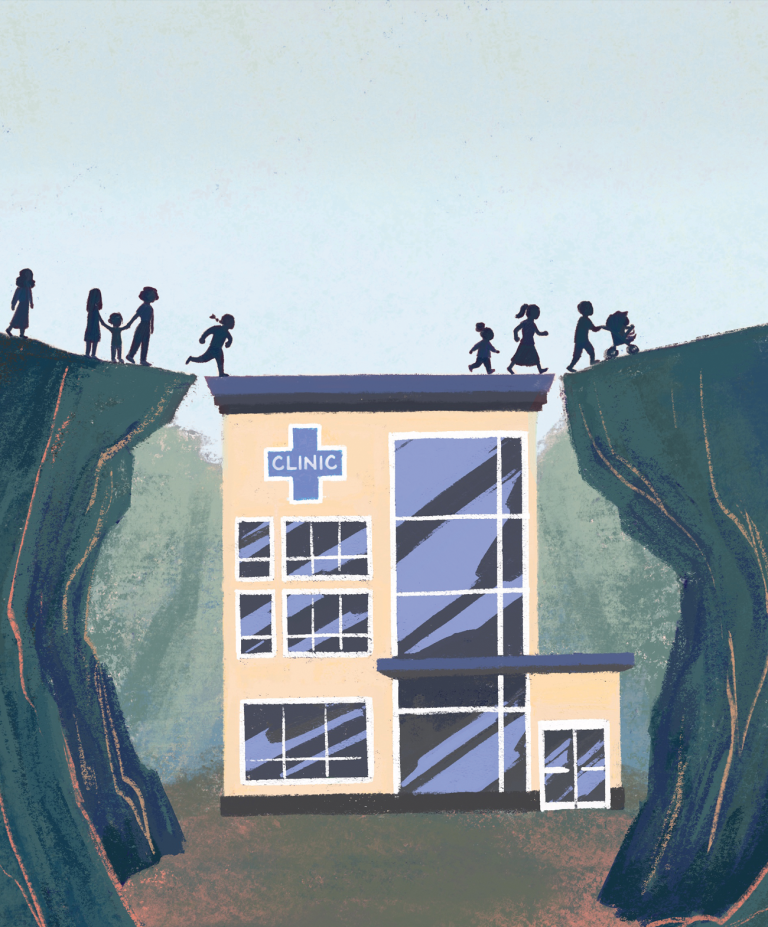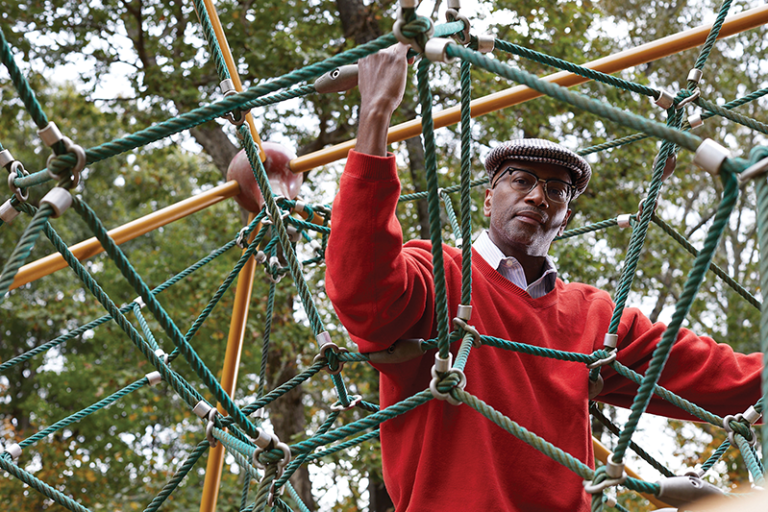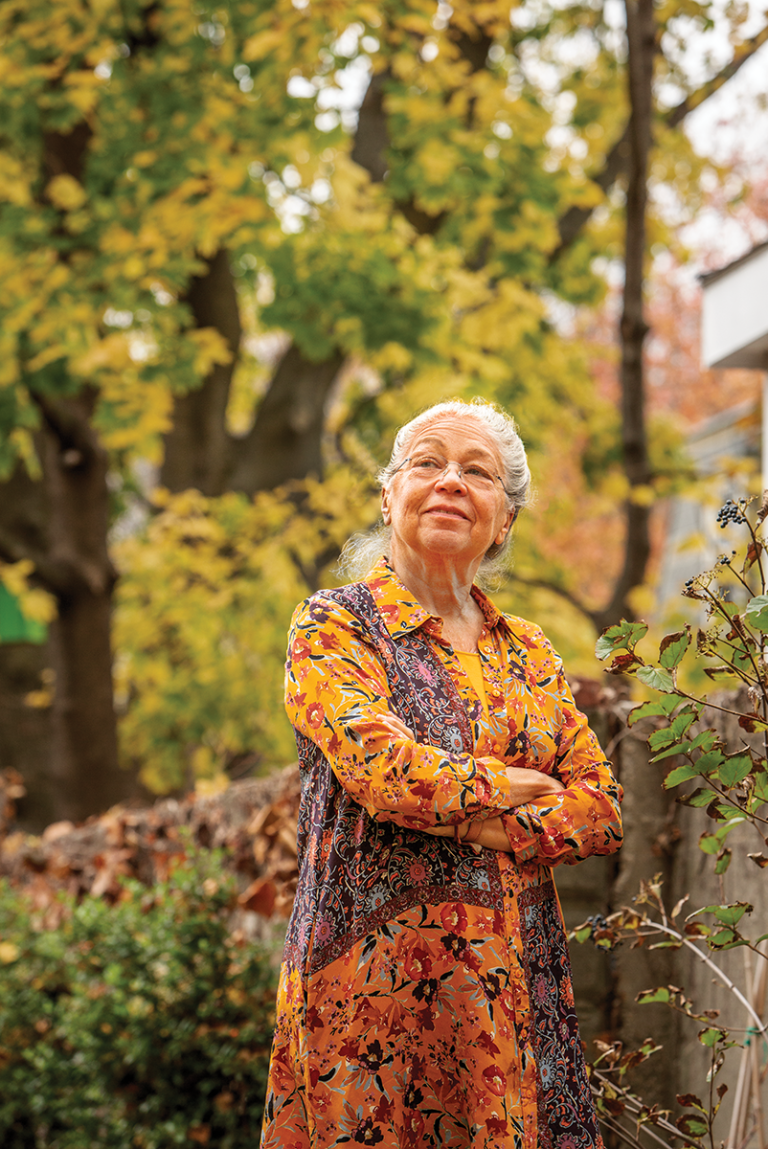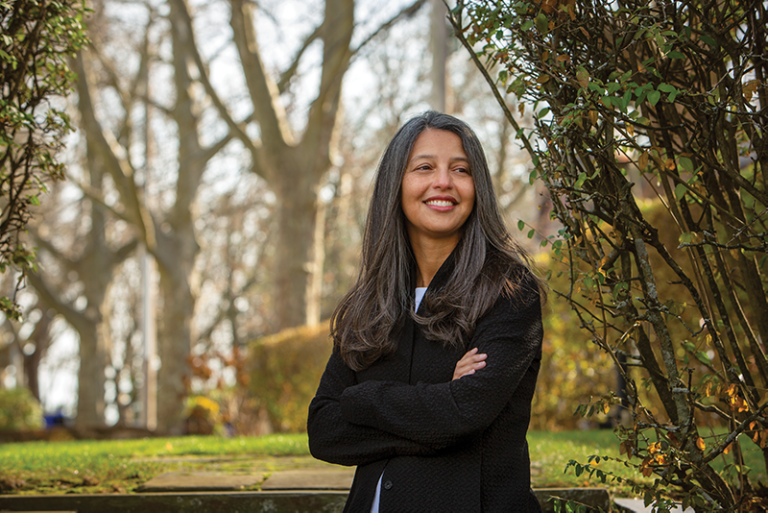Neighbors in Need
For decades, community health efforts have brought care to people in areas underserved, and often overlooked, by mainstream medicine
- 13 minute read
- Feature

Driving home from work one day, Charles Moore, MD ’91, took a detour. Propelled by nothing more than a list of three zip codes in the Atlanta area and a growing curiosity about his patient population, he exited Interstate 20 toward Bankhead. Moore wasn’t quite sure what he expected to find, but he pulled over, started walking, and struck up conversations with the people he met, simply chatting about the neighborhood.
“I didn’t tell them what I was there for, because I honestly didn’t know,” he recalls. “I just wanted to meet people and try to make a difference.”
A head and neck surgeon and chief of service in Grady Health System’s Department of Otolaryngology, Moore had chosen those zip codes based on what he had discovered in his patients’ charts. At Grady, he saw a slew of late-stage head and neck cancers in patients for whom palliative care was by then the only option. Many of these advanced cancers would have been treatable had Moore’s patients sought care sooner. When he took a deeper dive into their records, a pattern emerged: The majority of them resided within three zip codes, areas that represented impoverished neighborhoods plagued by unemployment, crime, and lack of resources.

For these patients, health care wasn’t a priority. Often without insurance and reliable transportation and faced with immediate concerns such as paying for food, rent, and utilities, they simply couldn’t make it one. It was a bleak conclusion that Moore drew based on his conversations during that and other after-work detours—and one that he realized could no longer go ignored.
“Every time I saw a patient with advanced cancer, I’d think to myself, Somebody needs to do something about this,” he says. “Then one day, I thought, Well, maybe that somebody should be me.”
A history of change
Moore didn’t realize it then—in fact, he says, community health was little more than a blip on his radar during medical school and residency—but he was following in the footsteps of activists who transformed health care delivery in both rural and urban neighborhoods across the United States.
Today, community health centers serve some 28 million patients, providing comprehensive, high-quality care in underserved communities, typically those characterized by poverty, elevated health risks, and a shortage of medical resources. Offering a range of services such as preventive and primary care, social services, and treatment for substance use disorders, they form the backbone of modern U.S. health care—and save the health care system more than $24 billion annually, according to the National Association of Community Health Centers.
“I’d think to myself, Somebody needs to do something about this. Then one day, I thought, Well, maybe that somebody should be me.”
This model of health care isn’t new. Elements of it have long been present around the globe, from Africa to Europe. Yet community health centers are a relatively recent phenomenon in the United States. Stemming from the civil rights movement of the 1960s, their roots grow deep in a state regarded as the epicenter of that movement: Mississippi.
It was 1964, the year of the Mississippi Freedom Summer Project, when hundreds of young people descended on the state with the goal of registering as many Black voters as possible. It was a violent summer, marked by bombings, arson, beatings, and the killings of civil rights workers and their supporters. Among the volunteers were doctors and nurses, there to provide medical protection for those registering voters and fighting for civil rights. These medical volunteers were led by Jack Geiger, a physician who, at that time, was the Mississippi field coordinator for the Medical Committee for Human Rights, a group that was essentially the medical arm of the civil rights movement. Geiger was a founding member of the medical committee.
Even as the summer wound down, Geiger kept returning to the state, often accompanied by Count Gibson, chair of the Department of Preventive Medicine at Tufts University School of Medicine. The department also focused on community medicine.
Like Moore would decades later in Georgia, Geiger and Gibson had become acutely aware of the dearth of medical care for native Mississippians. “That fall we kept going back to Mississippi,” Geiger would later say in an oral history for the Library of Congress. “We had started a small clinic staffed by volunteers and some other efforts to provide local health services. Nothing comprehensive, but the need was staggering.”
Inspired by his earlier medical rotations at community primary care centers in South Africa, Geiger pitched Gibson on a similar concept: a health center in Mississippi that would also serve as a catalyst for greater social change. By 1965, Geiger and Gibson had secured funding from the newly formed U.S. Office of Economic Opportunity—not just for a community health center in rural Mound Bayou, Mississippi, but also for one at Columbia Point, an urban housing project in Dorchester, Massachusetts.
Over the years, community health centers have grown, fueled by support from such disparate sources as the late Senator Ted Kennedy and the Black Panther Party, which established a series of community-based free clinics as part of the Panther’s mission to end systemic discrimination against Black people and the poor.
For the most part, community health efforts have enjoyed bipartisan support from politicians seeking cost-effective approaches to address poverty and related concerns. Yet programs supporting such efforts can remain strong only if government funding and backing remains intact. Community health efforts rely on the Affordable Care Act and the Community Health Center Fund. The latter, which was originally set to expire in May 2020, was extended through November as part of the Coronavirus Aid, Relief, and Economic Security Act. Because the future of such federal programs remains tenuous—and has been jeopardized under the Trump administration—some community health centers rely instead on state and local grants, private philanthropy, or a combination of these.
Regardless of how they receive funding, all community health centers follow a similar model: they are embedded in areas of need, have strong ties to the communities they serve, and are guided by the members of those communities.
In the right hands, this model can be quite successful.
Door-to-door care
For nearly three decades, residents of Boston communities with the highest burden of health disparities have had access to preventive screenings, health coaching, and referrals to health and social services—all without having to set foot in a brick-and-mortar clinic. This is the result of the Family Van, a mobile wellness unit that meets people where they live, work, play, and pray. The goals are to remove barriers to care, improve health, and address health care disparities in vulnerable neighborhoods.
“Imagine the difficulty when you have children, have multiple jobs, and are four bus lines away from your obstetrician. The health care system is absolutely not set up for the working poor.”
The van is the brainchild of Nancy Oriol, MD ’79, faculty associate dean for community engagement in medical education at HMS and an obstetric anesthesiologist. In 1990, a Boston Globe series “Birth in the ‘Death Zones’ ” shone a light on what Oriol had long observed in her patients: Infant mortality rates in Boston were linked to racial and ethnic disparities. Black and brown babies were dying at rates almost triple that for white infants, this in a city with some of the best medical facilities in the world. The Globe series was, she says, an “aha moment” for the public that cemented what she had already suspected—that obstacles to prenatal care might contribute to preterm birth, low birth weights, and infant mortality.
Oriol, who herself had grown up in a segregated, working class neighborhood in North Philadelphia that was similar to Boston’s Mission Hill area, was well aware of the challenges her patients faced. “No matter who you are, fitting prenatal care into your schedule can be difficult,” she says. “Imagine the difficulty when you already have children, have multiple jobs, and are four bus lines away from your obstetrician. The health care system is absolutely not set up for the working poor.”
A spark ignited, and for the next few years, Oriol and Cheryl Dorsey, MD ’92—then a student at HMS—hit the streets, meeting with everyone from sex workers to hospital presidents to learn what members of various communities thought might help them solve this problem. “Our work wasn’t based on any formal public health principles,” says Oriol. “We just asked people what they thought. It was crowdsourcing before that was a word.”
This community-based design process led them to a conclusion that surprised many health care experts. They wouldn’t be delivering prenatal care—or any treatment. Instead, they proposed a mobile health unit that would build a bridge to the health care system, demystifying it through education, and priming visitors to seek care at neighborhood health centers. The mobile health unit that was proposed became the Family Van and the places it would visit were determined by community partners throughout Boston’s underserved areas.

Funded in part by HMS, the Family Van offers advanced clerkship opportunities to HMS students. And, since its inception, the van’s staff members have collaborated with Boston-area community health centers. At times, staff from the various community health centers join the van’s team when the van is in their neighborhood. These centers, according to Oriol, recognize that the Family Van does more than remove barriers of transportation and cost; its informal curbside care also helps build trust among communities that have a history of mistrust of the mainstream health care system.
Before the COVID-19 pandemic, the Family Van followed a regular weekly route, each day at a specific location in a different neighborhood. Tuesdays, for example, brought the van to Nubian Square; Wednesdays to East Boston, and so on. “If we park in the right place, we’re busy,” says Oriol. “If not, we just move. This is the advantage of being mobile. If a neighborhood changes and the need for the mobile clinic changes, then we move.”
Regardless of its location, patients who board the van can access a number of preventive services at no cost, including blood pressure and cholesterol checks and diabetes screenings. Education is key: The staff of community health workers, dietitians, and counselors answer questions about anything from reproductive health to depression and can connect clients to resources such as health insurance and food service assistance as well as low-cost dental and medical services. At its core, the Family Van team is about listening, educating, and referring. “You don’t give up your agency when you come on the van,” says Oriol. “You’re driving the conversation, and we’re determining how we can help you accomplish your goals.”
The approach, which has been shown effective in helping to control patients’ blood pressure levels and other chronic concerns, has inspired efforts across the country. There are now about two thousand mobile health units in the United States, a number Oriol expects to grow, despite, or perhaps because of, COVID-19. “Both the pandemic and the current racial justice movement have unmasked a lot of the problems in our health care system,” she says. “Mobile health units work because they aren’t a cookie cutter of what we think people want. They’re flexible and adaptable enough to meet today’s needs.”
Among and within
Moore’s detours into Atlanta’s underserved neighborhoods led to his own impromptu mobile health unit. As he grew to understand the obstacles to care faced by his patients, he began offering free talks and screenings for head and neck cancer out of the back of his car. Soon, he realized that his patients’ other medical needs weren’t being addressed and expanded his offerings to include primary care.
“Someone had told me that if these people wanted care, they would come to me,” he says. “I knew that wasn’t true.”
Instead, Moore met patients where they were, sometimes under bridges or in drug houses—and he kept coming back, determined to earn their trust. It worked. After screening a man in a homeless shelter and discovering an early larynx cancer, he worried that the patient wouldn’t be able to get himself to the hospital for treatment. But the man showed up, having walked some 15 miles. “He told me that no one had ever cared before and that he was set on getting there,” Moore recalls.
Eventually, Moore found that people wanted a fixed location in their community for care. The result, the HEALing Community Center, is a federally qualified health center that provides comprehensive health care services, including oral and mental health and health education, all available to patients on a sliding payment scale. The center has four sites throughout Atlanta, each of which is accessible by public transportation.
Moore, who now directs Emory University’s Urban Health Initiative, is also looking to the future. In early 2021, he’ll break ground on a housing complex, located in what he refers to as a low-wealth neighborhood, which will also offer on-site health care services, educational resources, and a community garden—an echo of Geiger’s efforts to create a community-run farm co-op in 1960s Mississippi.
More for more
Growing up in Manhattan in the shadow of a large academic medical center, Elsie Taveras, an HMS professor of pediatrics at Massachusetts General Hospital, saw the effects of health inequities on members of her community. “The medical center wasn’t prepared for the influx of low-income immigrant families and their health and social needs,” she recalls. Like many of her peers, Taveras received much of her primary care in hospital emergency departments. “It was an early experience that stayed with me. You could see the downstream health effects of people deferring treatment and not receiving preventive care.”

Those experiences spurred a lifelong commitment to addressing health disparities. “I couldn’t understand how a country with so many resources like the United States still had issues of poor access to care,” says Taveras. “I wanted to uncouple the relationship between poverty and adverse health outcomes.”
In 2017, Taveras, then a pediatrician at Mass General, was asked to lead the hospital’s Kraft Center for Community Health. At the time, the center—which had been endowed by Robert Kraft and the Kraft family to help increase access to high-quality care among underserved populations—was in transition. For the previous four years, its main focus had been on training the next generation of physicians in community health. Now, it was ready to pivot, moving to more boots-on-the-ground programs.
As its executive director, Taveras has helped guide the center into its current form, which includes work in areas that have the most common conditions that threaten at-risk populations, such as obesity, cardiovascular disease, cancer, and substance use disorder.
The center’s Community Care in Reach mobile health initiative, for example, delivers addiction services, preventive care, and harm reduction resources such as syringe exchanges to four neighborhoods in Boston that have high numbers of fatal opioid overdoses. The program is the result of partnerships with the Boston Health Care for the Homeless Program, the Massachusetts Department of Public Health, and others. In just two years, the mobile unit has served thousands, providing proof that when care is easy to access, people will access it.
Taveras and her colleagues are also studying the effect of the center’s community efforts. A trained epidemiologist, she’s proud to bring the rigor of clinical trials to her health equity work. Indeed, in 2019, the National Cancer Institute recognized the center’s work in cancer prevention with one of its Cancer Moonshot grants, funding that now supports the new Implementation Science Center for Cancer Control Equity. The Kraft Center also recently received one of the National Institutes of Health’s Rapid Acceleration of Diagnostics (RADx) awards, aimed at improving COVID-19 testing in underserved communities.
The center’s work wouldn’t be possible without strong partnerships with the communities themselves, says Taveras. “We engage neighborhood associations, community health centers, and patients in everything we do. We listen and design solutions with them in mind, not just apply what we think is best.” It’s an approach that’s helping to transform care for vulnerable populations, a long-held goal for Taveras. “Our mission speaks to exactly why I went into medicine,” she says. “It’s my kind of true north.”
Jessica Cerretani is a Boston-based writer.
Illustration: Angela Hsieh. Images: John Soares (Oriol and Taveras); Nick Burchell (Moore)